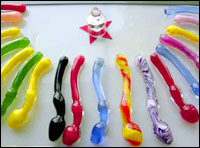So you’re an Enlightened Green Consumer. You buy organic food and carry it home from the local market in string bags. Your coffee is shade-grown and fair-trade, your water’s solar-heated, and your car is a hybrid. But what about the playthings you’re using for grown-up fun between those organic cotton sheets — how healthy and environmentally sensitive are they?

Peace and coital unto you.
Photo: Lise Gagne/iStockphoto.
Few eco-conscious shoppers consider the chemicals used to create their intimate devices. Yes, those things — from vibrators resembling long-eared bunny rabbits to sleeves and rings in shapes ranging from faux female to flower power. If these seem like unmentionables, that’s part of the problem: while some are made with unsafe materials, it’s tough to talk about that like, well, adults.
But it’s necessary. Unlike other plastic items that humans put to biologically intimate use — like medical devices or chew-friendly children’s toys — sex toys go largely unregulated and untested. And some in the industry say it’s time for that to change.
Love Stinks
Many popular erotic toys are made of polyvinyl chlorides (PVC) — plastics long decried by eco-activists for the toxins released during their manufacture and disposal — and softened with phthalates, a controversial family of chemicals. These include invitingly soft “jelly” or “cyberskin” items, which have grown popular in the last decade or so, says Carol Queen, Ph.D., “staff sexologist” for the San Francisco-based adult toy boutique Good Vibrations. “It’s actually difficult for a store today to carry plenty of items and yet avoid PVC,” Queen says. “Its use has gotten pretty ubiquitous among the large purveyors, because it’s cheap and easy to work with.”
In recent years, testing has revealed the potentially serious health impacts of phthalates. Studies on rats and mice suggest that exposure could cause cancer and damage the reproductive system. Minute levels of some phthalates have been linked to sperm damage in men, and this year, two published studies linked phthalate exposure in the womb and through breast milk to male reproductive issues.
A study in 2000 by German chemist Hans Ulrich Krieg found that 10 dangerous chemicals gassed out of some sex toys available in Europe, including diethylhexyl phthalates. Some had phthalate concentrations as high as 243,000 parts per million — a number characterized as “off the charts” by Davis Baltz of the health advocacy group Commonweal. “We were really shocked,” Krieg told the Canadian Broadcasting Corporation’s Marketplace in a 2001 report on the sex-toy industry. “I have been doing this analysis of consumer goods for more than 10 years, and I’ve never seen such high results.”
The danger, says Baltz, is that heat, agitation, and extended shelf life can accelerate the leaching of phthalates. “In addition, [phthalates are] lipophilic, meaning they are drawn to fat,” he says. “If they come into contact with solutions or substances that have lipid content, the fat could actually help draw the phthalates out of the plastic.” Janice Cripe, a former buyer for Blowfish — a Bay Area-based online company whose motto is “Good Products for Great Sex” — confirms the instability of jelly toys: “They would leak,” she says. “They’d leach this sort of oily stuff. They would turn milky” and had a “kind of plasticky, rubbery odor.” She stopped ordering many jelly toys during her time at Blowfish, even though their lower prices made them popular.
So what’s being done to protect consumers? Well, nothing. While the U.S., Japan, Canada, and the European Union have undertaken various restrictions regarding phthalates in children’s toys, no such rules exist for adult toys. In order to be regulated in the U.S. under current law, sex toys would have to present what the federal government’s Consumer Product Safety Commission calls a “substantial product hazard” — essentially, a danger from materials or design that, in the course of using the product as it’s made to be used, could cause major injury or death. But if you look at the packaging of your average mock penis or ersatz vagina, it’s probably been labeled as a “novelty,” a gag gift not intended for actual use. That’s an important semantic dodge that allows less scrupulous manufacturers to elude responsibility for potentially harmful materials, and to evade government regulation. If you stick it somewhere it wasn’t meant to go, well — caveat emptor, baby!
It’s a striking lack of oversight for a major globalized industry. The Guardian recently estimated that 70 percent of the world’s sex toys are manufactured in China, and the CBC’s 2001 report suggested the North American market might be worth $400 million to $500 million.
More detailed figures can be hard to come by. “In the U.S., all of the companies that manufacture adult novelties, whether they’re mom-and-pop or large corporations, are privately held,” explains Philip Pearl, publisher and editor in chief of AVN Adult Novelty Business, a trade magazine. “None are required to publish financial information, and none do.”
Queen thinks the lack of agreed-upon standards is a major problem. She and the staff at Good Vibrations have often had to fall back on marginally relevant regulations. “I remember trying in the early ’90s to track down information on an oil used on beautiful hand-carved wooden dildos — was it safe to put into the body?” she says. “The closest comparison we could find was the regulation governing wooden salad utensils!”
Taking Things Into Their Own Hands
Metis Black, president of U.S.-based erotic-toy manufacturer Tantus Silicone, has written on the health risks of materials for Adult Novelty Business. “Self-regulation — eventually we’ve got to do it,” says Black, who adds that creating safe toys is what got her into the business about seven years ago. “Just like children’s teething toys, we’re going to have to start doing the dialogue” within the industry, Black says, to “discuss what’s in toys and how it affects customers.” Otherwise, she feels, government regulators will step in.
While the industry wrestles with such issues, some manufacturers and suppliers aren’t waiting for regulations. Tony Levine, founder of Big Teaze Toys, says he’s made his products — including the cutely discreet, soft-plastic vibrator I Rub My Duckie — phthalate-free from the start. “While working at Mattel as a toy designer, I was made very aware of the concerns of using only safe materials for children’s products,” he says. “This training has stuck with me … We take great pride in using only the materials which meet strict toxicity safety standards for both the U.S. and the E.U.”
Meanwhile, if customers select jelly playthings at Babeland, a retailer with stores in Los Angeles, New York City, and Seattle, the staff gives them a tip sheet on phthalates, and recommends using a condom with the toy. “Our goal is to help people make an educated choice, and give out as much information as we can find — without alarming people,” says Abby Weintraub, an associate manager at the company’s Soho store.
Babeland staff also steer willing customers toward phthalate-free alternatives, such as hard plastic, or the silicone substitute VixSkin. Some manufacturers are also using thermoplastic elastomers instead of PVC. Vibratex recently reformulated the popular Rabbit Habit dual-action vibrator — made famous on Sex and the City — with this material. Vibratex co-owner Daniel Martin says the company has always used “superior grade,” stable PVC formulations, and still considers the products safe, but acknowledges that customers are eager for phthalate-free tools. While alternative materials can be more expensive, Weintraub says when people have the option of choosing them, many do.
The owners of the Smitten Kitten, a Minneapolis-based retailer, opted not to carry jellies, cyberskins, or other potentially toxic toys at all when they opened about two years ago. “They’re dangerous to human health, to the environment,” says co-owner Jennifer Pritchett. “It’s part of our philosophy to put good things in the world, and it’s counter to that to sell things that are toxic.”
No Sex Please, We’re Skittish
So what are the other alternatives for eco-conscious pleasure-seekers? The most ecologically correct choices may be metal or hardened glass dildos — which, with their elegant, streamlined shapes (and sometimes hefty price tags) can double as modernist sculptures if you grow weary of their sensual charms. “The glass is going to be more lasting, possibly safer, and less toxic than something that’s plastic,” confirms Babeland marketing manager Rebecca Suzanne.
And the eco-choices don’t stop there. If you want to do your part for conservation while getting a buzz, go for the Solar Vibe, a bullet vibrator that comes wired to a small solar panel. Some vibrators come with rechargeable power packs, says Suzanne, “which is a little bit better alternative to the typical battery-run toy, where you just toss the batteries … into the landfill.”
What about accessories? The Smitten Kitten takes pride in its “animal-friendly” inventory of bondage and fetish gear. “We have some floggers that are made of nylon rope … natural rope, and rubber,” says Pritchett. “The same with the paddles, collars, cuffs, and whatnot. Totally leather-free, animal-product-free.”
A few manufacturers are bringing green values directly to the adult-toy market via products that might not be out of place in the cosmetics aisle of a natural-foods mega-retailer. Offerings include Body Wax’s candles made from soy and essential oils, and Sensua Organic’s fruit-flavored or unflavored lubes — one of a few lubricant lines touting either organic or all-natural formulations. “People enjoy having the option,” says Weintraub. “It’s like, ‘I use organic face wash. Maybe I want to use organic lube, too.'”
Pritchett feels health and eco-conscious retailers are a shopper’s best ally for staying safe and healthy. “So many of us are used to shopping for organic food, or ecologically safe building products, or cosmetics,” she says. When people realize it’s possible to shop for sex toys the same way, “you can see a light bulb go off — they realize it’s a consumer relationship and they can and should demand better products.”
Choosing the most eco-correct erotic toy can seem fraught with compromises — more akin to picking the most fuel-efficient automobile than buying a bunch of organic kale. With no government assessment or regulation on the immediate horizon, it’s up to you, the consumer, to shop carefully and select a tool that’s health-safe, fits your budget, and gets your rocks off. Meanwhile, pack up that old mystery-material toy and send it back to the manufacturer with a note that they can stick it where the sun don’t shine.




